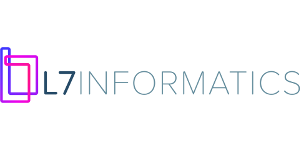
In this interview, Vasu Rangadass – President and CEO of L7 Informatics – and I explore the company’s origins, its unique ESP technology, future directions, and more. Enjoy!
Interview with Vasu Rangadass, President and CEO of L7 Informatics
Cade Hildreth: What is your professional background?
President and CEO of L7 Informatics
Vasu Rangadass: Most of my professional career I’ve been involved with data management and data models to represent real-world processes inside computer software programs, so that we can plan, visualize and optimize these processes. I did my PhD work in machine learning and artificial intelligence and hold several patents in “Master Data Management” (MDM), Enterprise “Operating Systems”, and Workflow Management as well as extensive process experience in several industries including life sciences and healthcare.
My first job out of school was at i2 Technologies (now JDA). In addition to becoming a billion dollar company in 12 years, it revolutionized the way manufacturing and supply chains are modelled and optimized. At i2 we used innovative approaches based on the principles of Six-Sigma, operations research, and process optimization and were responsible for optimizing factories and supply chains of several global fortune 500 companies, including Dell, Toshiba, Texas Instruments, PepsiCo, Samsung, Phillips, Walmart, and others.
I was the first employee at i2 and very quickly learned that the key to good software is always about how closely you can model reality of the factory or the supply chain within your program. The way your data model goes, so goes the value your software can generate. That is a key point that most software companies forget.
After 18 years at i2, I started a company called Net.Orange, which built a unique platform called the “clinical operating system” to simplify and optimize care delivery processes in health systems. I sold Net.Orange to NantHealth and served as their Chief Strategy Officer for over 3 years. NantHealth is a next-generation, personalized healthcare company enabling more effective treatment decisions for critical illnesses and improved patient outcomes.
About 18 months ago, I took over as the CEO of L7 Informatics.
Cade Hildreth: How did you become involved with L7 Informatics?
Vasu Rangadass: I knew the investors in L7 Informatics from one of my previous companies. The investors were looking for an executive with strong operational background in software with experience in life sciences and healthcare industries to run L7.
I got a call 18 months ago and the rest is history.
Cade Hildreth: When was L7 Informatics founded and what is its focus?
Vasu Rangadass: L7 was founded in 2013 and its product the Enterprise Science Platform (ESP) platform was designed to integrate wet lab processes and dry lab processes (NGS & bio-informatics) into a single seamless workflow. We learnt a lot about data management and life science process automation while bridging these two silos with ESP. We have since broadened our scope to include all of optimization and data management across research, clinical trials and manufacturing.
The DNA of the company has strong roots in laboratory science, computer science, bio-informatics, computational biology, manufacturing and supply chain management.
Cade Hildreth: What is the Enterprise Science Platform (ESP) launched by L7 Informatics?
Vasu Rangadass: L7’s Enterprise Science Platform (ESP) platform was developed originally to integrate wet lab processes and dry lab processes (NGS & bio-informatics) into a single seamless workflow. We have since expanded the scope of ESP by adding support for manufacturing processes and making the platform fully GMP, GLP and GCP compliant.
This allows ESP to automate and capture data across entirety of the cell therapy process (lab, logistics, clinical and manufacturing) creating a single source of truth solution that enables life science companies and healthcare systems to connect people, processes, instruments, software and equipment to not only optimize their RMAT processes, but also to accelerate discoveries, optimize research processes across labs, and apply it for a broad range of precision health diagnostic and treatment processes.
Cade Hildreth: In your opinion, what is the role of “Companion Informatics” for supporting data and process management within the rapidly expanding Cell and Gene Therapy (CGT) sector?
Vasu Rangadass: We believe “Companion Informatics,” which is the virtual digital twin of the entire needle-to-needle cell therapy process, is a critical part of precision medicine solutions that will enable the high-quality delivery of n=1 therapies each and every time. This single companion informatics solution will eliminate all manual processes and multiple software solutions (LIMS, MES, Process control) that introduce high variability and data silos into these critical processes thereby increasing the overall quality and reducing the cost of the drug produced.
We need complete data integrity and automation across the clinical, manufacturing and logistics processes. This cannot be achieved with existing systems that are currently in place.
Cade Hildreth: What other industries and clients type does L7 Informatics serve with the ESP platform?
Vasu Rangadass: L7 Informatics mainly serves academic and government precision medicine research labs, health systems, life sciences and bio-pharma industries. Most of our customers are looking to us to provide a single system that can integrate their instruments and equipment and automate their cell therapy processes and at the same time collect data across the process generating single source of truth data repository that then becomes the MBR and the QMS.
Cade Hildreth: L7 Informatics recently held a webinar providing a look at how Gradalis, a clinical-stage immuno-oncology cell therapy company, is using the ESP platform from L7 to streamline its research, clinical, and manufacturing operations. How would you describe the ways in which the ESP platform has transformed operations at Gradalis?
Vasu Rangadass: Gradalis was siloed with a lot of paper quality system and we have created a single source of truth system that has complete data integrity, because we have eliminated manual data entry and manual data calculations by directly integrating to systems and instrument. Using the process automation capabilities we have also eliminated the need of having multiple siloed systems, such as LIMS, MES, Process Management, eMBR and eQMS.
Cade Hildreth: What trends are you seeing within Cell and Gene Therapy (CGT) and how are L7 Informatics’ technologies rising to meet them?
Vasu Rangadass: We look at these trends through the lens of a knowledge management or information management solution provider. Innovative and highly complex treatments, such as cell and gene therapies, cost more to develop and commercialize than even traditional large molecule biologics. This underscores the need for a better way to seamlessly leverage information from early stage research and development, all the way through clinical development and commercial production using the L7 ESP platform.
So, from the perspective of a solution provider, we look at three trends. In many ways these trends mirror what happened many years ago with recombinant proteins.
Product trends – Gene therapy (which at the moment consists mostly of viral vectors) and cell therapies (both allogeneic and autologous) are rapidly transitioning to wide spread acceptance, as new and highly effective modalities for the treatment of grievous human illnesses.
Process trends – While there are fundamental differences in production processes for these types of products, the processes and methods used for these products are rapidly maturing. Most of the common challenges are being identified and resolved, and the approaches to resolution of these challenges are being standardized.
And finally, instrumentation and processing technologies – We are seeing a lot of consolidation as larger players in the industry not only develop their own technologies aimed at the cell and gene therapy (CGT) market, but also acquire promising new technologies (and companies) in order to offer a broader set of capabilities aimed at this market segment. GE, Millipore Sigma, and Sartorius are just some examples of larger players. Furthermore, these technologies are being adapted and improved from ones used in research into technologies able to be used in a GMP environment.
As an example, one of the most common techniques used in cell therapy, Flow Cytometry, was used primarily in research labs and academic settings just a few years ago, but it is now being commonly used in QC labs for product testing and release. A lot of changes had to be made to make the technique more consistent and the software cGMP and 21 CFR 11 compliant.
Cade Hildreth: What are your 5-year goals for L7 Informatics?
Vasu Rangadass: Our primary goal is to automate and optimize precision medicine processes.
We provide our clients the means for achieving their objective faster and more cost effectively. The trends I referred to earlier of common approaches, standardization, and consolidation actually pave the way for us by reducing the diversity of the systems with which ESP will need to seamlessly integrate.
Cade Hildreth: How can people get in touch with you or learn more about L7 Informatics?
Vasu Rangadass: People can visit our website www.l7informatics.com to learn more about L7 Informatics and get in touch with me directly by emailing me at vasu.rangadass@l7informatics.com.
Do you have questions or comments about L7 Informatics? Share them in the comments below.
